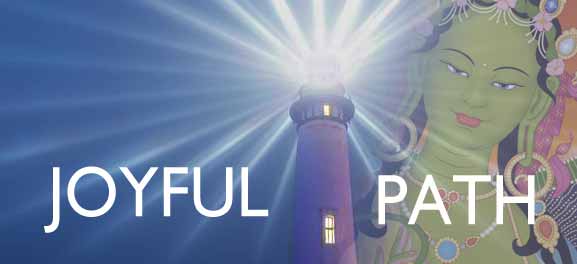Chanting
Chanting is a simple, easy to learn practice that can have profound benefits. Research has shown that when we sing choral songs or chant mantras together that we breathe together, our hearts beat together and we may experience a sense of relaxation and deeper connection. When chanting alone, research indicates we might find that chanting reduces anxiety and depression, creates a sense of alignment, decreases mental chatter, releases neurosis, boosts immunity, cultivates compassion, and soothes the senses. It is possible that there are additional benefits to chanting mantras or prayers that have been said for hundreds or thousands of years. Joyful Path periodically offers workshops in chanting as well as private instruction. Below are some of the most common chants we cover in our classes, although we can also assist you individually in identifying and learning chants in your primary tradition.
How to Chant Mantras
There is a lot of helpful information on chanting and mantra — far more than can be covered in a single Web page. However, the following instruction can help you get started in a chanting practice.
You can say the mantra at any time, but for longer periods you can sit comfortably in a chair or on a cushion with the spine erect. The mantra is said or chanted in a circular manner so that there is no pause between ending the mantra and beginning it again. Some people find it helpful to say mantra in the car, but do not induce a meditative state if you are driving or operating heavy machinery or in situations where you need to be fully alert to stay safe.
- Take a breath at any time, letting the mantra continue in your mind without pausing.
- In public, you can recite mantra silently from the heart center.
- In private it is best to say or chant the mantra out loud. You can do so very quietly or more loudly.
- It some traditions it is not necessary to enunciate the mantra or to pronounce it perfectly, it is more important to just try it sincerely.
- Chanting traditionally involves the body, speech and mind. For the body component, some people like to use prayer beads and pull one bead for each mantra. Prayer beads can be acquired at Joyful Path or in our shop. You do not need prayer beads to get started.
The Mantra of Compassion: Om Mani Padme Hum
The ‘Mani” mantra is said to be the most widely recited of all Buddhist mantras, and open to anyone who feels inspired to practice it. There are various ways of chanting this mantra, according to various traditions. The following short recording was made during a summer storm, when participants who were attending a teaching on altruism were asked to move to the basement of Joyful Path for their safety. The explanation of chanting continued as we waited out the storm. We feel the last few rounds of the chant are particularly sweet as the group comes together.
Listen to a short explanation and then chant the mantra:
You might also enjoy:
- His Holiness the Dalai Lama explains the meaning of the Mani mantra (~ 5 minutes, external link opens in a new tab)
- Ani Choying Dolma chants the Mani mantra (~2 minutes, external link opens in a new tab)
- Mercedes Behleda chants the Mani mantra with music (~ 11 minutes of music, external link opens in new tab)
Peace Mantra: Lokah Samastah Sukhino Bhavantu
Although most mantras we share are from the Buddhist tradition, Nichala Joy Devi introduced this peace mantra to one of our founders during yoga certification training, and a prayer including this mantra is chanted as part of our interfaith peace prayers. The recording below is of our longtime member Pam (Pema Norbu), who studied the Hindu scriptures for many years.
According to Sri Mata Amritanandamayi Devi “Amma’s” website, this mantra represents the spirit of the existent Vedic branches and comes from,“svasti prajabhya: paripalayantham nyayeana margena mahim maheesah, gobrahmanebhya shubamsthu nityam lokah samastha sukhino bhavanthu,” translated as,
“May there be well being to the people;
May the kings rule the earth along the right path;
May the cattle and the Brahmins have well being forever;
May all the beings in all the worlds become happy;
Peace, peace and peace be everywhere!”
You might also enjoy:
- Tina Turner chanting Sarvesham Svastir Bhavatu, we include a version of this prayer in our interfaith peace prayers (~ 5 minutes, external link opens in new tab)
